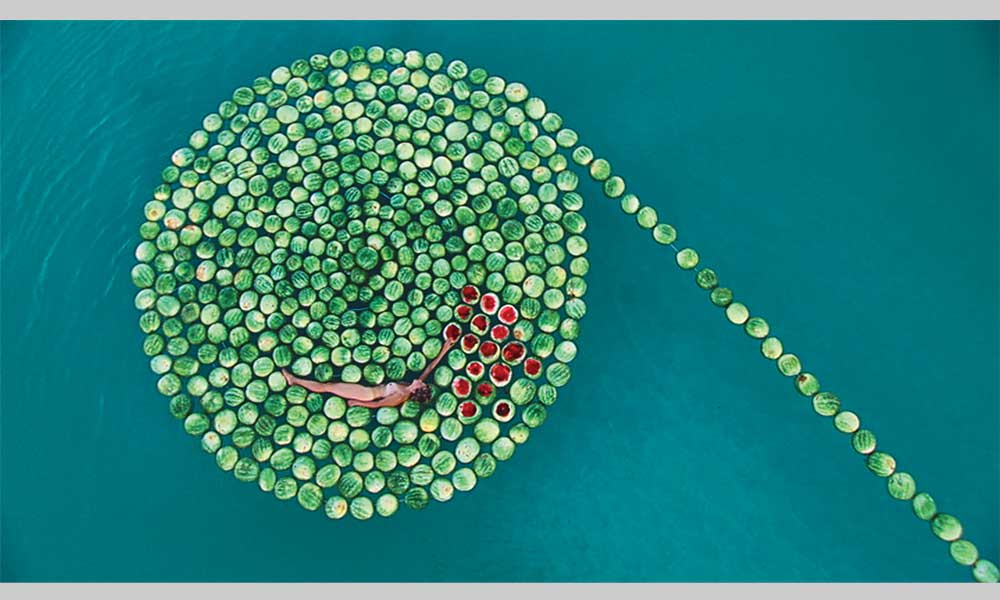Fishing nets, a ballet tutu, a baptismal font, boots, a barbed-wire lamp shade and watermelons. All are integral to “The Burning Sea,” an exhibition on view at The Israel Museum, Jerusalem featuring the evocative work of renowned Israeli artist Sigalit Landau. For some 20 years Landau has been creating art inspired by and dedicated to the Dead Sea, a subject, says Israel Museum director Denis Weil, “that holds specific significance and finds new context at the Israel Museum as home to the Dead Sea Scrolls.”
Landau’s innovative sculptures, large-scale installations, videos and photographs reference ancient myths, historical events and classic images. At the same time, they also forge a personal, environmental and political connection to the present, exploring the issues and political divisions surrounding the sea’s unique environment and highlighting the man-made ecological disaster there. “I see my works as both laments and robust ‘souvenirs’ from a sea that is on a path heading toward extinction,” says Landau.
Highlighting the exhibition are new works and sculptures from the artist’s series of objects—stretchers, nets, a handmade tapestry—transformed by the Dead Sea’s salt-rich waters. These objects, some scavenged from the sea, were all subjected to a process of crystallization in the sea’s salty waters, which turned these ordinary and practical items into salt-encrusted, otherworldly, time-defying works of art.

A tutu dress coated in salt crystals is raised from its bath in the Dead Sea in 2016. (Photo credit: Shaxaf Haber / Yotam From)
The art Landau has created in this primal moonscape, the lowest land-based elevation on earth, explores the dualities of life and death, injury and healing, destruction and hope—a central theme of the current exhibition and a motivating force behind Landau’s art. “Working outside the studio, away from usual artistic practices,” she has said, “gave me freedom. For me, creating art at the sea meant escaping the civilized world somewhat and being ex-territorial.”

Salt-encrusted objects seem to float on air in the Israel Museum, Jerusalem’s installation of Sigalit Landau’s exhibition “The Burning Sea.” (Photo credit: Shaxaf Haber / Yotam From)
Born in Jerusalem in 1969, Landau first encountered the Dead Sea on family outings as a child and began incorporating it into her art in the early 2000s. From her bedroom in the French Hill neighborhood of northern Jerusalem, she could watch the sun rise over the Dead Sea and the mountains of Moab, and on evening walks on a nearby hilltop, she could see the moon’s reflection in the water. Back then, the area of the Dead Sea was more than double what it is now.

De Deux (detail), 2017. A tutu embellished with salt crystals after immersion in the sea takes its place as a work of art in “The Burning Sea.” (Photo credit: Shaxaf Haber / Yotam From)
One of the world’s natural marvels, the Dead Sea draws numerous visitors for its beauty and unique health properties. Unable to sustain aquatic life because of its high salinity (it is ten times as salty as the ocean), it is abundantly rich in a variety of minerals, including potash and bromine. Surrounded by desert on both sides and scorched by the sun, the Dead Sea has been drying up at an alarming rate, due in part to reduced flow from the Jordan River and mineral extraction. Its banks are collapsing, it has just one-third the surface area it had 50 years ago and its water level is dropping close to 4 feet every year—distressing indications of a dying sea.

Still from the video Island in the Sun [Bridge II], 2022, in which Landau exposed an array of shoes she placed on a natural salt island in the Dead Sea to the blanching effects of the salt. (Photo credit: All images: © Sigalit Landau, courtesy The Israel Museum, Jerusalem / Yotam From)

Salt Crystal Bridal Gown (Sigilit Landau and Yotam From) is suspended under the water of the sea in a work-in-progress video, 2014. (Photo credit: All images: © Sigalit Landau, courtesy The Israel Museum, Jerusalem / Yotam From)
The show premieres a new video work titled Island in the Sun (Bridge II) depicting a pile of shoes Landau assembled on a natural salt island in the Dead Sea that gradually turns white as the shoes are exposed to the blanching effects of the salt. The exhibition also explores Landau’s recurring use of watermelons, a symbol of life and sweetness, including her famed video work DeadSee (2005), in which she floats in the sea amid a spiral of watermelons. Another work, Watermelon Table (2007), suggests the imagery of Leonardo da Vinci’s The Last Supper, with watermelon pieces placed on a table of salt, causing them to continually change form as they react to the salt.

The video Across the Divide (Bridge III), 2022, features a young man walking on a tightrope above the landscape of the Dead Sea looking eastward. (Photo credit: All images: © Sigalit Landau, courtesy The Israel Museum, Jerusalem / Yotam From)
A key part of the exhibition is dedicated to the idea of a bridge from the Israeli to the Jordanian side of the Dead Sea, a proposal Landau has been working on for more than a decade. She created an installation titled Salt Bridge Summit for the 2011 Venice Biennale that posits a bridge—symbolic and actual—between cultures, religions, opinions and peoples—a bridge over “burning” water.
“After so many years of making art at the Dead Sea,” Landau told the show’s curator Amitai Mendelsohn, “I see this sea as a place for coming together. The environmental tragedy that both we and our neighbors must cope with can become a unique opportunity to realize our shared destiny in a concrete way. To recognize the fluidity of this troubled body of water as well as water’s scarcity and its importance. Working together—even on a conceptual bridge—would mean realizing our interdependence.”


